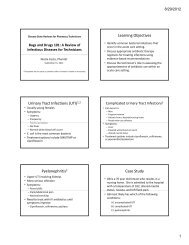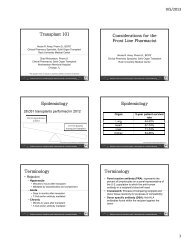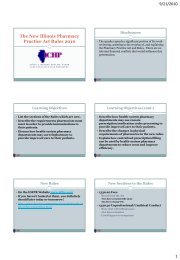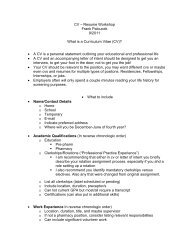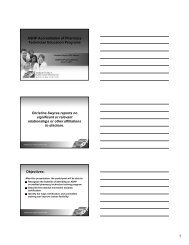- Page 1 and 2:
ACTIVITY DESCRIPTION Target Audienc
- Page 3 and 4:
Current Challenges • Expansion of
- Page 5 and 6:
Examples of Medication Consideratio
- Page 7 and 8:
Etiology (Dana Point, 2008) 1’. P
- Page 9 and 10:
PAH Therapy Targets Schulze-Neick I
- Page 11 and 12:
Chronic Adjuvant Therapies in PAH D
- Page 13 and 14:
Cummulative suurvival Survival in I
- Page 15 and 16:
ACCF/AHA Consensus PAH Treatment Al
- Page 17 and 18:
Study Name Drug SUPER-1 Oral silden
- Page 19 and 20:
IV Epoprostenol in PAH Due to Scler
- Page 21 and 22:
70 60 50 40 30 20 10 Inhaled Ilopro
- Page 23 and 24:
Conclusions • PAH therapy improve
- Page 25 and 26:
ESC/ERS Guidelines Galie N, et al.
- Page 27 and 28:
FUTURE DIRECTIONS WHICH MAY IMPACT
- Page 29 and 30:
Rationale for “Front-Loaded” Ap
- Page 31 and 32:
Addressing gthe Challenges g in PAH
- Page 33 and 34:
Considerations • Central vs. peri
- Page 35 and 36:
Pulmonary Hypertension • Approxim
- Page 37 and 38:
Example Cassette Calculations • V
- Page 39 and 40:
Assessment Question 1 Which of the
- Page 41 and 42:
Illinois Council of Health‐System
- Page 43 and 44:
Patient Activity ‐ 1 Patients in
- Page 45 and 46:
Hospitalists National Trends • Ja
- Page 47 and 48:
Pharmacy Landscape • PGY‐2: So
- Page 49 and 50:
Primary Care Physicians by Field, F
- Page 51 and 52:
Health Systems Pharmacy and TATAI
- Page 53 and 54:
Readings The 21 Irrefutable Laws of
- Page 55 and 56:
What is a “Practice Model”? •
- Page 57 and 58:
Completing the Self Assessment •
- Page 59 and 60:
Residency trained (B23p) Illinois N
- Page 61 and 62:
Solving the PPMI Puzzle ‐ Here Ar
- Page 63 and 64:
Overview of Value Based Purchasing
- Page 65 and 66:
Implementation of Medication‐ rel
- Page 67 and 68:
Question #1 Within which programs a
- Page 69 and 70:
Solving the PPMI Puzzle‐ Here are
- Page 71 and 72:
Discharge Education/Med Rec • New
- Page 73 and 74:
Media‐Worthy Trials? Making Sense
- Page 75 and 76:
Prevention of Recurrent VTE • Unp
- Page 77 and 78:
VTE recurrence during study period
- Page 79 and 80:
Which patient might be a candidate
- Page 81 and 82:
Azithromycin and CV Death • Endpo
- Page 83 and 84:
Azithromycin and CV Death Azithromy
- Page 85 and 86:
Hormonal Contraception and VTE •
- Page 87 and 88:
• Age • Calendar year • Educa
- Page 89 and 90:
ARR=2.20, 2.28 for stroke, MI when
- Page 91 and 92:
Which of the following combinations
- Page 93 and 94:
3 Months of Treatment for Latent TB
- Page 95 and 96:
3 Months of Treatment for Latent TB
- Page 97 and 98:
T/F: Rifapentine in combination wit
- Page 99 and 100:
2. Which of the following statement
- Page 101 and 102:
Fitting the Counseling Piece into M
- Page 103 and 104:
Current Evidence: Implementing Bund
- Page 105 and 106:
Teach Back Process • Step 1 Expla
- Page 107 and 108:
Questions for Consideration and Dis
- Page 109 and 110:
Why do we care about ADE? • Adver
- Page 111 and 112:
True or False • Medication errors
- Page 113 and 114:
Check Point Which of the following
- Page 115 and 116:
Proactive Screening Process Patient
- Page 117 and 118:
MTI Pilot at NAH PharmD Students tr
- Page 119 and 120:
ASHP PPMI Case Study Adding Value:
- Page 121 and 122:
Interdisciplinary Teamwork: How Phy
- Page 123 and 124:
Highly Effective Healthcare • Wha
- Page 125 and 126:
Inter‐Professional Teams ‐ Chan
- Page 127 and 128:
Meeting the PPMI Goals for Technolo
- Page 129 and 130:
Drug‐Bug Mismatch Example Con’t
- Page 131 and 132:
Drug‐Bug Mismatch Build Rules •
- Page 133 and 134:
Meeting the PPMI Goals for Technolo
- Page 135 and 136:
Patient Scanning Compliance Sample
- Page 137 and 138:
Meeting the PPMI Goals for Technolo
- Page 139 and 140:
Global Immunizations 3 • Jan 2012
- Page 141 and 142:
Mobile Devices: Beyond Angry Birds
- Page 143 and 144:
Google Play • Google Play - Inter
- Page 145 and 146:
Other Useful Productivity Apps •
- Page 147 and 148:
Mobile Devices: Beyond Angry Birds
- Page 149 and 150:
Net Activations by Industry Source:
- Page 151 and 152:
News Readers/Aggregators Features S
- Page 153 and 154:
Contact Information • E‐mail: -
- Page 155 and 156:
Early‐Onset Sepsis • Sign and s
- Page 157 and 158:
• BR is on day 2 of cefotaxime wi
- Page 159 and 160:
Immunizations: The Superheroes to P
- Page 161 and 162:
Current ACIP Recommendations Influe
- Page 163 and 164:
Herpes Zoster Vaccine Recommendatio
- Page 165 and 166:
Assessment Questions 1. What are th
- Page 167 and 168:
HIV Linkage and Retention in Care T
- Page 169 and 170:
DHHS Guidelines, March 2012: When t
- Page 171 and 172:
Protease Inhibitors • Require “
- Page 173 and 174:
Mean Change (mg/ /dL) STARTMRK: Lip
- Page 175 and 176:
RAL Drug Interactions • Does not
- Page 177 and 178:
Instructions for Credit In order to
- Page 179 and 180:
Staging Stage Criteria (Durie‐Sal
- Page 181 and 182:
Salvage Therapy Partial List Regime
- Page 183 and 184:
Bortezomib-Thalidomide-Dexamethason
- Page 185 and 186:
Case 2 ST is a 76 y/o African Ameri
- Page 187 and 188:
Thalidomide and Lenalidomide • Ad
- Page 189 and 190:
Fixed Low-Dose Warfarin Study Thera
- Page 191 and 192:
New Drugs 2012 Anna Nowobilski‐Va
- Page 193 and 194:
Pulmonology » Cystic Fibrosis •
- Page 195 and 196:
Oncology » MTX Toxicity • MTX 1o
- Page 197 and 198: NEW DRUGS AND BIOLOGICALS 2012 RESO
- Page 199 and 200: Disease State Reviews for Pharmacy
- Page 201 and 202: Chronic Obstructive Pulmonary Disea
- Page 203 and 204: Disease State Reviews for Pharmacy
- Page 205 and 206: Green Zone • Patient is not havin
- Page 207 and 208: Disease State Reviews for Pharmacy
- Page 209 and 210: • A hormone produced by the pancr
- Page 211 and 212: Unraveling Unraveling The The Puzzl
- Page 213 and 214: The Reward Center In time, serious
- Page 215 and 216: So what makes addicted pharmacists
- Page 217 and 218: How to find a treatment center Onli
- Page 219 and 220: Internet Drug Abuse Study conducted
- Page 221 and 222: NIAAA = best resource for alcohol d
- Page 223 and 224: Impact of Postoperative Pain • Pi
- Page 225 and 226: Safety Profile • Amar et al confi
- Page 227 and 228: References 1. Rømsing J, Møiniche
- Page 229 and 230: Society of Regional Anesthesia Meet
- Page 231 and 232: A New Approach IV Acetaminophen •
- Page 233 and 234: References • Schechter, Leslie N.
- Page 235 and 236: Bupivacaine liposome injectable sus
- Page 237 and 238: Error Potential • Inadvertent IV
- Page 239 and 240: Decolonization Methods • Anti-sep
- Page 241 and 242: Evidence: Inpatient ICU MRSA Coloni
- Page 243 and 244: Residency Project Pearls Adherence
- Page 245 and 246: 650 subjects id identified tifi d R
- Page 247: Overtreatment versus Appropriate Tr
- Page 251 and 252: Background • Lack of comprehensiv
- Page 253 and 254: Results Results‐User User Audits
- Page 255 and 256: Special thanks to: • Carol Heunis
- Page 257 and 258: Antibiotic Prophylaxis American Hea
- Page 259 and 260: Study Limitations • Dependent on
- Page 261 and 262: Study Background • Observation of
- Page 263 and 264: A patient has a CrCl of 25 mL/min.
- Page 265 and 266: • Cysteine hydrochloride: antioxi
- Page 267 and 268: Sample Preparation • Intravenous
- Page 269 and 270: Questions? Residency Project Pearls
- Page 271 and 272: The Interview: Your Preparation •
- Page 273 and 274: PGY1 Residency Options Carol Heunis
- Page 275 and 276: RESIDENCY PROGRAM BASICS • Progra
- Page 277 and 278: CV: The key to a top curriculum vit
- Page 279 and 280: Tips for a Top Notch CV • Focus o
- Page 281 and 282: What is PhORCAS? • PhORCAS is the
- Page 283 and 284: Piecing together the new CHEST guid
- Page 285 and 286: Initiating therapy CHEST 2012 2.1.8
- Page 287 and 288: What is “Consistently Stable?”
- Page 289 and 290: Puzzle # 2A: patient has just compl
- Page 291 and 292: What would you do for JJ? • A. Ho
- Page 293 and 294: Considerations for SB • Bleeding



